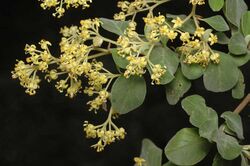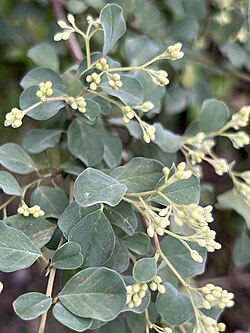Biology:Pomaderris brogoensis
| Pomaderris brogoensis | |
|---|---|

| |
| In the Australian National Botanic Gardens | |
| Scientific classification | |
| Kingdom: | Plantae |
| Clade: | Tracheophytes |
| Clade: | Angiosperms |
| Clade: | Eudicots |
| Clade: | Rosids |
| Order: | Rosales |
| Family: | Rhamnaceae |
| Genus: | Pomaderris |
| Species: | P. brogoensis
|
| Binomial name | |
| Pomaderris brogoensis N.G.Walsh[1]
| |
Pomaderris brogoensis is a species of flowering plant in the family Rhamnaceae and is endemic to south-eastern New South Wales. It is a slender shrub or spreading tree with hairy branchlets, egg-shaped to more or less round leaves, and clusters of yellowish flowers.
Description
Pomaderris brogoensis is a slender shrub or spreading tree that typically grows to a height of up to 9 m (30 ft), its stems covered with white and rust-coloured hairs. The leaves are egg-shaped with the narrower end towards the base to more or less round, 6–20 mm (0.24–0.79 in) long, 5–14 mm (0.20–0.55 in) wide with lance-shaped stipules mostly 3–5 mm (0.12–0.20 in) long at the base, and covered with star-shaped hairs. The flowers are borne in pyramid-shaped panicles, each flower on a densely hairy pedicel about 2 mm (0.079 in) long. The sepals are golden yellow, oblong and 1.6–2.0 mm (0.063–0.079 in) long but there are no petals. The stamens alternate with the sepals and are 1.0–1.3 mm (0.039–0.051 in) long.[2][3]
Taxonomy
Pomaderris brogoensis was first formally described in 1988 by Neville Grant Walsh in the journal Muelleria from specimens collected by David Albrecht in the Bemboka State Forest in 1986.[2][4] The specific epithet (brogoensis) refers to the type location.[2]
Distribution and habitat
This pomaderris usually grows on steep, north-facing slopes and occurs in scattered locations, mostly in the upper catchments of the Brogo River on the South Coast and Southern Tablelands of New South Wales.[2][3]
References
- ↑ "Pomaderris brogoensis". Australian Plant Census. https://biodiversity.org.au/nsl/services/apc-format/display/93498. Retrieved 15 January 2022.
- ↑ 2.0 2.1 2.2 2.3 Walsh, Neville G. (1988). "Two new species of Pomaderris Labill. (Rhamnaceae) from south-eastern New South Wales. Muelleria". Muelleria 6 (6): 429–431. https://www.biodiversitylibrary.org/page/49825859#page/45/mode/1up. Retrieved 15 January 2022.
- ↑ 3.0 3.1 Harden, Gwen J.. "Pomaderris brogoensis". Royal Botanic Garden Sydney. https://plantnet.rbgsyd.nsw.gov.au/cgi-bin/NSWfl.pl?page=nswfl&lvl=sp&name=Pomaderris~brogoensis.
- ↑ "Pomaderris brogoensis". Australian Plant Name Index. https://biodiversity.org.au/nsl/services/rest/instance/apni/516486. Retrieved 15 January 2022.
Wikidata ☰ Q17271138 entry
 |


